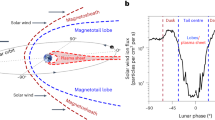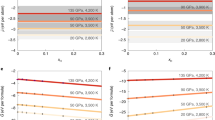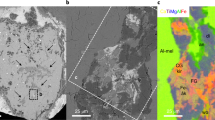Abstract
Jets of water ice from surface fractures near the south pole1 of Saturn’s icy moon Enceladus produce a plume of gas and particles2,3,4,5. The source of the jets may be a liquid water region under the ice shell—as suggested most recently by the discovery of salts in E-ring particles derived from the plume6—or warm ice that is heated, causing dissociation of clathrate hydrates7. Here we report that ammonia is present in the plume, along with various organic compounds, deuterium and, very probably, 40Ar. The presence of ammonia provides strong evidence for the existence of at least some liquid water, given that temperatures in excess of 180 K have been measured near the fractures from which the jets emanate8. We conclude, from the overall composition of the material, that the plume derives from both a liquid reservoir (or from ice that in recent geological time has been in contact with such a reservoir) as well as from degassing, volatile-charged ice.
This is a preview of subscription content, access via your institution
Access options
Subscribe to this journal
Receive 51 print issues and online access
$199.00 per year
only $3.90 per issue
Buy this article
- Purchase on Springer Link
- Instant access to full article PDF
Prices may be subject to local taxes which are calculated during checkout



Similar content being viewed by others
References
Porco, C. C. et al. Cassini observes the active south pole of Enceladus. Science 311, 1393–1401 (2006)
Dougherty, M. K. et al. Identification of a dynamic atmosphere at Enceladus with the Cassini Magnetometer. Science 311, 1406–1409 (2006)
Waite, J. H. et al. Cassini Ion and Neutral Mass Spectrometer: Enceladus plume composition and structure. Science 311, 1419–1422 (2006)
Hansen, C. J. et al. Enceladus’ water vapor plume. Science 311, 1423–1425 (2006)
Spahn, F. et al. Cassini dust measurements at Enceladus and implications for the origin of the E ring. Science 311, 1416–1418 (2006)
Postberg, F. et al. Sodium salts in E-ring ice grains from an ocean below the surface of Enceladus. Nature 459, 1098–1101 (2009)
Kieffer, S. W. et al. A clathrate reservoir hypothesis for Enceladus’ south polar plume. Science 314, 1764–1766 (2006)
Spencer, J. et al. High spatial resolution observations of thermal emission from Enceladus’ active south pole. Eos 89 (Fall Meet. Suppl.), abstr. P23B-1372 (2008)
Waite, J. H. et al. The Cassini Ion and Neutral Mass Spectrometer (INMS) investigation. Space Sci. Rev. 114, 113–231 (2004)
Owen, T. On the origin of Titan’s atmosphere. Planet. Space Sci. 48, 747–752 (2000)
Niemann, H. B. et al. The abundances of constituents of Titan’s atmosphere from the GCMS instrument on the Huygens probe. Nature 438, 779–784 (2005)
Lopes, R. M. C. et al. Cryovolcanic features on Titan’s surface as revealed by the Cassini Titan Radar Mapper. Icarus 186, 395–412 (2007)
Roberts, J. H. & Nimmo, F. Tidal heating and the long-term stability of a subsurface ocean on Enceladus. Icarus 194, 675–689 (2007)
Tobie, G., Čadek, O. & Sotin, C. Solid tidal friction above a liquid water reservoir as the origin of the south pole hotspot on Enceladus. Icarus 196, 642–652 (2008)
Matson, D. L., Castillo, J. C., Lunine, J. I. & Johnson, T. V. Enceladus’ plume: compositional evidence for a hot interior. Icarus 187, 569–573 (2007)
Bockelée-Morvan, D., Crovisier, J., Mumma, M. J. & Weaver, H. A. in Comets II (eds Festou, M. C., Keller, H. U. & Weaver, H. A.) 391–423 (Univ. Arizona Press, 2004)
Glein, C. R., Zolotov, M. Y. & Shock, E. L. The oxidation state of hydrothermal systems on early Enceladus. Icarus 197, 157–163 (2008)
Miyakawa, S. et al. The cold origin of life: A. Implications based on the hydrolytic stabilities of hydrogen cyanide and formamide. Orig. Life Evol. Biosph. 32, 195–208 (2002)
Lodders, K. & Fegley, B. A Planetary Scientist’s Companion (Oxford Univ. Press, 1998)
Zolotov, M. Y. An oceanic composition on early and today’s Enceladus. Geophys. Res. Lett. 34 L23203 10.1029/2007GL031234 (2007)
Meyer, J. & Wisdom, J. Tidal heating in Enceladus. Icarus 188, 235–239 (2007)
Geiss, J. & Gloeckler, G. Abundances of deuterium and helium in the protosolar cloud. Space Sci. Rev. 84, 239–250 (1998)
Horner, J., Mousis, O., Alibert, Y., Lunine, J. I. & Blanc, M. Constraints on the formation of icy bodies in the Jovian system and beyond. Planet. Space Sci. 56, 1585–1595 (2008)
Canup, R. M. & Ward, W. R. Formation of the Galilean satellites: conditions of accretion. Astron. J. 124, 3404–3423 (2002)
Mousis, O. et al. Clathration of volatiles in the solar nebula and implications for the origin of Titan's atmosphere. Astrophys. J. 691, 1780–1786 (2009)
Shock, E. L. & McKinnon, W. B. Hydrothermal processing of cometary volatiles: applications to Triton. Icarus 106, 464–477 (1993)
Hansen, C. J. et al. Water vapour jets inside the plume of gas leaving Enceladus. Nature 456, 477–479 (2008)
Schmidt, J., Brillantov, N., Spahn, F. & Kempf, S. Slow dust in Enceladus' plume from condensation and wall collisions in tiger stripe fractures. Nature 451, 685–688 (2008)
Nimmo, F., Spencer, J. R., Pappalardo, R. T. & Mullen, M. E. Shear heating as the origin of the plumes and heat flux on Enceladus. Nature 447, 289–291 (2007)
Fortes, A. D. Metasomatic clathrate xenoliths as a possible source for the south polar plumes of Enceladus. Icarus 191, 743–748 (2007)
Acknowledgements
Support by the Cassini Project through a subcontract with Southwest Research Institute is acknowledged.
Author Contributions J.H.W. organized and coordinated the plume composition study. J.H.W., C.R.G., W.S.L., J.I.L., W.B.M., O.M., M.-J.N. and J.W. developed the concept of the Letter and the interpretation of the INMS data. W.S.L., J.I.L., W.B.M., C.R.G. and O.M. worked jointly to write the manuscript. B.A.M. analysed the data and prepared the spectra. D.T.Y., T.B. and B.D.T. analysed the physical and chemical interactions of the inflowing material with the INMS antechamber and, together with B.A.M. and C.R.G., prepared the Supplementary Information. H.B.N. provided calibration support and information about instrument performance. R.L.M., M.P. and W.-H.I. provided supporting analysis of the neutral and ion environment surrounding Enceladus.
Author information
Authors and Affiliations
Corresponding author
Supplementary information
Supplementary Information
This file contains Supplementary Methods and Data, Supplementary Figures S1-S4, Supplementary Tables S1-S7 and Supplementary References. (PDF 1491 kb)
Rights and permissions
About this article
Cite this article
Waite Jr, J., Lewis, W., Magee, B. et al. Liquid water on Enceladus from observations of ammonia and 40Ar in the plume. Nature 460, 487–490 (2009). https://doi.org/10.1038/nature08153
Received:
Accepted:
Issue Date:
DOI: https://doi.org/10.1038/nature08153
This article is cited by
-
MASPEX-Europa: The Europa Clipper Neutral Gas Mass Spectrometer Investigation
Space Science Reviews (2024)
-
Low effective ultraviolet exposure ages for organics at the surface of Enceladus
Communications Earth & Environment (2023)
-
Earth shaped by primordial H2 atmospheres
Nature (2023)
-
Detection of HCN and diverse redox chemistry in the plume of Enceladus
Nature Astronomy (2023)
-
JWST molecular mapping and characterization of Enceladus’ water plume feeding its torus
Nature Astronomy (2023)
Comments
By submitting a comment you agree to abide by our Terms and Community Guidelines. If you find something abusive or that does not comply with our terms or guidelines please flag it as inappropriate.



